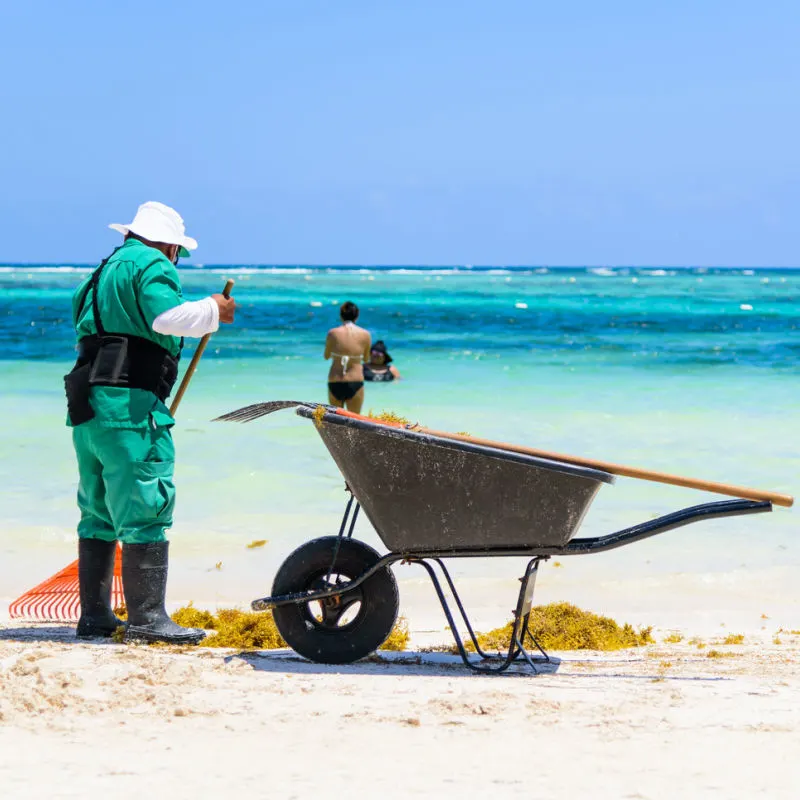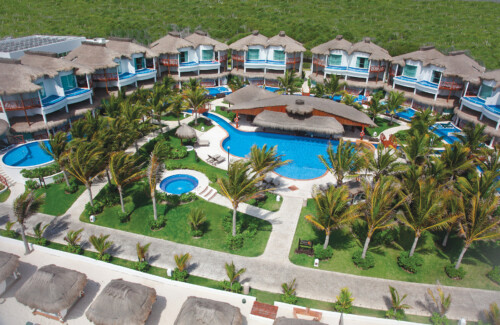You may have seen the recent news that a massive 5000-mile-long blob of seaweed is approaching Florida. Those of us who specialize in planning destination weddings in Mexico and the Caribbean have heard about seaweed or seagrass in Mexico and the Caribbean for a while now.
What exactly is sargassum?
Some call it seaweed, and some call it seagrass, but we’re all talking about sargassum. Sargassum is a brown seaweed that floats in the ocean and is an important habitat for migratory organisms, like crabs, shrimp, turtles, and certain fish species.
It’s called sargassum seaweed because it originates from the world’s largest algae bloom in the Sargasso Sea between Western Africa and the United States.
Why does sargassum smell?
The seaweed can be unsightly as it washes ashore on the beach, but if you’ve ever experienced it first-hand, you probably remember a smell associated with the sargassum.
Sargassum smells because as it washes ashore, it rots and puts off hydrogen sulfide – which smells like rotten eggs.
What are the resorts in Mexico doing to stop sargassum?
 While this has become a bigger story in the United States due to the 5,000-mile-long seaweed belt moving toward Florida, resorts in Mexico, mainly, have been dealing with this seaweed for many years.
While this has become a bigger story in the United States due to the 5,000-mile-long seaweed belt moving toward Florida, resorts in Mexico, mainly, have been dealing with this seaweed for many years.
The good news is that hotels and the local government have iterated on their action plans to manage the seaweed that washes ashore over the years. Even more recently, resorts have announced a new plan to deal with the sargassum.
If you’ve been to a resort in the past few years, you’ve probably seen people raking the seaweed throughout the day and moving it off the beach. Some resorts have more heavy-duty machinery, like a beach cleaner truck going down the coast to clear the seaweed en masse.
Some resorts have gone as far as implanting barriers off their beaches attempt to prevent the seaweed from washing ashore.
When is seaweed season in Mexico?
One of the main questions from couples looking to host their destination wedding in Mexico is how to avoid seaweed. It can be unsightly and give off that pungent egg smell that makes your wedding experience less pleasant.
Scientists have found that “seaweed season” more regularly occurs from May to October. There’s no specific “start of the season,” but generally, the warmer temperatures in the spring and summer mean more seaweed.
What is the best time to host a destination wedding to avoid seaweed?
Because the seaweed is more pronounced from May to October in the warmest months of the year, we recommend aiming for late October to April if you want to host a beach wedding in Mexico.
There’s no way to guarantee it won’t rain during your destination wedding (we wish there were!). There’s similarly no way to ensure no seaweed during your events. Scheduling your wedding from October to April is one way to raise the odds your event will be seaweed-free.
Where is the best place to host a destination wedding to avoid seaweed?
 In our many years of traveling to Mexico, we’ve noticed something pretty crazy. On the same day, you can go from beach to beach, resort to resort, and the levels of seaweed may vary significantly.
In our many years of traveling to Mexico, we’ve noticed something pretty crazy. On the same day, you can go from beach to beach, resort to resort, and the levels of seaweed may vary significantly.
The Hotel Zone in Cancun and Isla Mujeres tend to have less seaweed than other popular destination wedding locations like Costa Mujeres and Riviera Maya.
Depending on where your guests travel, you can also get married on the west coast of Mexico in popular locations like Puerto Vallarta, Los Cabos, and Riviera Nayarit. These locations have tradeoffs, especially if your guests are traveling from the east coast of the United States or if you want a popular weekend when resort prices may be sky-high.
Outside of Mexico, Punta Cana and Jamaica aren’t immune to seaweed, but they don’t have it as naturally occurring as around Cancun and Riviera Maya.
What venues are the best for avoiding seaweed in Mexico?
 One interesting destination wedding trend we’ve observed is that getting married directly on the beach is becoming less popular. Resorts are building venues like terraces, piers, rooftop terraces, and other venues providing incredible views overlooking the beach and ocean.
One interesting destination wedding trend we’ve observed is that getting married directly on the beach is becoming less popular. Resorts are building venues like terraces, piers, rooftop terraces, and other venues providing incredible views overlooking the beach and ocean.
These venues, like the Pier at Generations Riviera Maya, provide a dreamy backdrop without you and your guests seeing or potentially smelling seaweed during your nuptials or reception.
Can my wedding coordinator do anything to help with the seaweed?
Your dedicated on-site wedding coordinator isn’t a superhero (although they may seem like one!). They’re well-trained to manage wedding events and can even forecast the seaweed.
It’s the same as a thunderstorm occurring on your wedding day. Your wedding coordinator will monitor the situation and work with you on alternative venues if they expect a sub-optimal scenario.
Recap: Seaweed in Mexico for your destination wedding
The sargassum situation has recently become more discussed, but the resorts in Riveria Maya and Cancun have been dealing with it for years. While it can be unpleasant, the resorts manage the situation well.
Just like you can’t predict the weather, you can’t predict the seaweed situation, but that doesn’t mean you shouldn’t consider hosting your destination wedding in Mexico. Mexico is one of the most popular places to host a wedding, with many of our favorite resorts.
Staff at resorts, from the groundskeepers to the wedding teams, have become quite adept at dealing with the sargassum seaweed. From constantly removing it to providing alternative locations if the seaweed forecast looks bad, they are well-equipped to manage your destination wedding and give you the day you’ve been dreaming about.
Don’t let the stories or Facebook groups scare you. There are ways to plan accordingly and still host the dream destination wedding you’re hoping for without seaweed being someone’s stinky plus one.
Need help planning your destination wedding?
Our experienced wedding planners at Destination Weddings by Vacationeeze are with you every step of the way.
With decades of experience planning hundreds of weddings, our team understands what couples are looking for and how to navigate working with the resorts.
Our dedicated team will work with all your friends and family so you can focus on planning your dream wedding.
Ready to start planning your big day?
Call us at 215-454-2070 or get in touch with us here.





















